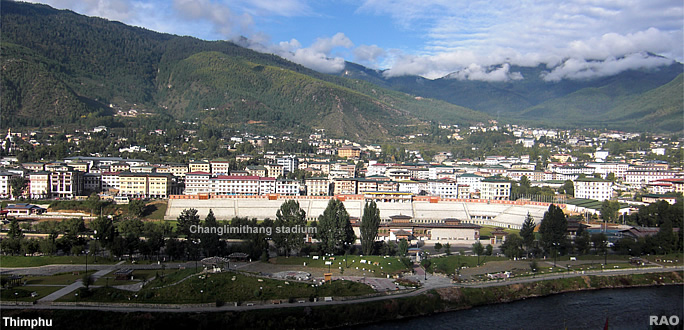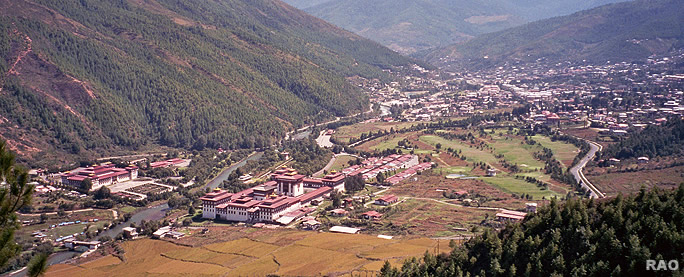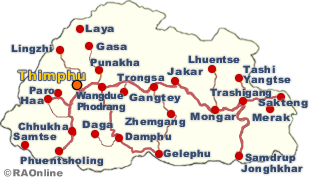 |
Bhutan's Tourism Thimphu |
 |
Bhutan Information |
|
|
 |
| Thimphu
- Capital of Bhutan |
 |
|
|
| Thimphu
is Bhutan's capital city .It is located in the west of Bhutan. Latitude 27°N,
Longitude 89°E .
Thimphu
is modern in age only: new buildings are still based on traditional designs
with elaborately painted trefoil-shaped windows and nailless wooden frames.
Among
its sights are the Memorial Chorten (dedicated to the king's late
father Jigme Dorji Wangchuck) and the Tashicho Dzong a 350-year-old
structure built by Zhabdrung Ngawang Namgyal and refurbished in
1961 to house government departments and ministries. |
|
The
king's throne room is in this Dzong. As the nation's largest monastery
it is the summer quarters of 2 000 monks and the Je Khenpo, the spiritual
leader and head of the monk body. Next to the Dzong is Thimphu's only golf
course.
Also
in town are the Changgankha Monastery and the early-17th-century
Simtokha Dzong (fortress-turned-university of the Buddhist studies).
top
 |
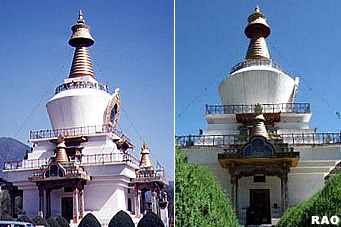 |
| Memorial
Chorten in Thimphu |
Memorial
Chorten in Thimphu |
Shop
for local crafts at the multilevel Government Handicraft Emporium (where you can also cash traveler's checks) or at one of several privately
run emporiums (Choeki Handicrafts is a good choice for its wide selection
and reasonable prices). Budding painters and sculptors can be seen at work
at the National Art School and tours to the National Library Jungshi
Paper Factory and Royal Academy of Performing Arts are rewarding
cultural experiences.
Stop
at the Swiss Bakery, a frequent hangout for tourists and expatriates
for pastries and coffee.
Thimphu's
weekend market is the biggest in Bhutan and well worth a stop. Although
many of the crafts items are manufactured imports from India and Nepal
the extensive area of fresh grains and vegetables is worth at least an
hour's walk-through.
Most
important aspect Thimphu is its culture and its natural beauty, both of
them giving it a unique advantage. Make sure that you have visited all
the important attractions in Thimphu in the first place. Shopping for exotic
items in the local markets and handicrafts emporiums is an experience in
itself and shows you many aspects of local culture that is religiously
protected from outside influences. Spicy cousins of Bhutan have no parallel
on earth and dining in some ethnic restaurant is an unforgettable experience.
Entire region around Thimphu has excellent trekking routes of different
levels giving you ample opportunities for hiking, trekking, river rafting,
and wildlife excursions.
| Thimphu
Dzongkhag |
 |
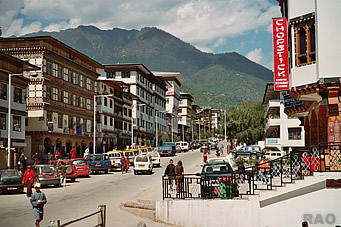 |
| Thimphu
is amongst the more developed dzongkhags in the country. The dzongkhag
has a relatively good road network, especially in the lower gewogs. The
gewogs in the northern part of the dzongkhag, which have a rugged and mountainous
terrain with extreme cold climate, are connected only by mule tracks making
access and delivery of development services difficult and expensive. Most
of the lower gewogs in the dzongkhags have easy access to the national
referral hospital, national research centers, central ministries, and agriculture
related corporations and the fmancial institutions. |
|
Further,
extension services are available in all gewogs and so are facilities for
primary education and health care. 60 % of the households are supplied
with electricity.
Thimphu
has an area of about 1,819 sq.km with elevation ranging between 1,300 to
over 7,300 meters above sea level. The dzongkhag has one drungkhag and
10 gewogs. Bapisa, Chang, Dagala, Genye, Kawang, Mewang and Toepisa gewogs
fall directly under the Dzongkhag Administration while the three gewogs
of Lingzhi, Naro, and Soe are under the Lingzhi Drungkhag Administration.
The lower valley gewogs in the dzongkhag are already relatively developed
compared to other regions in the country with wide telecommunication and
road coverage, and good access to local markets. Rice, which is the staple
food, is grown extensively by a majority of the people in gewogs like Bapisa,
Chang, Toepisa, Kawang, Mewang and Genye.
People also cultivate wheat as
a winter crop. The dry land owned by the people is used for orchard plantation
and vegetable cultivation for commercial purposes. The other more remote
gewogs in the alpine region, namely Dagala, Soe, Naro and Lingzhi, depend
on livestock farming as the main economic activity. Thimphu, the capital
town, is also located in the dzongkhag. By the Ninth Plan, Chang (except
for a few villages) and a portion of Kawang Gewogs will come under the
jurisdiction of the Thimphu municipality. Considering this, only a few
relevant programs have been planned for Chang, while Kawang will continue
to remain as a gewog.
Source:
Thimphu Dzongkhag
top
| Information on Bhutan |
 |
| Links |
 |
 |
 |
External
links |
|





